699 Search Results for communication book
October 22, 2013
by Carole Zangari -
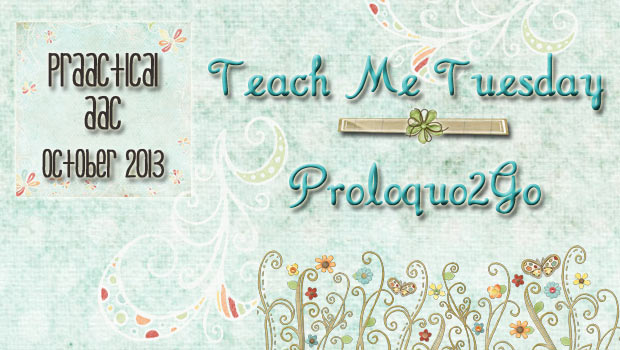
This week in Teach Me Tuesday we’re learning more about Proloquo2Go (P2G) by AssistiveWare. Here are the learning resources we’ll be using. Getting Started Webinars (on the right) Overview/Intro to P2G 3 Core Word Vocabulary-How to Customize It and Basic Communication Vocabulary: How to Customize It P2G Options, Part 1 and Part 2 Buttons, Clues, & Resources Making Back Ups and Saving: Save, Transfer & Restore a Backup Using iTunes for Windows Save, Transfer & Restore a Backup Using iTunes for Mac OS X Save, Transfer & Restore a Backup Using Dropbox Save, Transfer & Restore a Backup Using Using WiFi Getting Help within the P2G App Beyond the Basics Advanced Customization VocaPriority: Prioritize Vocabulary by How Frequently It Gets Used For those who Used the Original P2G Upgrading to P2G 2 Moving from the Old Vocabulary to the New Ones Discussion board/forum by AssistiveWare Manuals and documents by AssistiveWare Connect with AssistiveWare... [Read More...]
October 21, 2013
by Robin Parker -
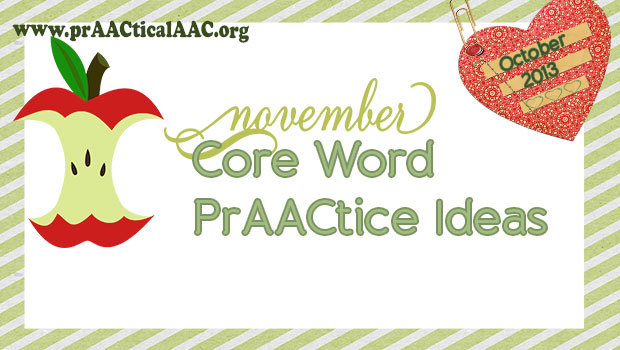
More core word prAACtice ideas. Whether you are just getting started or have been working with core word vocabulary for a long time, the teaching strategies you use to TEACH, helps turn regular words into real communication and language. Provide Aided Language Input- ALI in Meaningful Language Experiences. PrAACtice USING core words in many, many opportunities. Authentic, meaningful prAACtice is fun for everyone. This core word prAACtice is for November. There is a lot of food, leaves, changes of weather, thankfulness, sharing, and holiday spirit. Here are some ideas of activities that can go with the core word words, phrases and sentences: Do art project– Make a turkey because there are many opportunities to use body. From asking for the ‘body of the turkey” and asking for “feathers of the body” there can 50-100 opportunities for prAACtice. You can do this with a beginning communicator who can ask for a... [Read More...]
October 18, 2013
by Robin Parker -
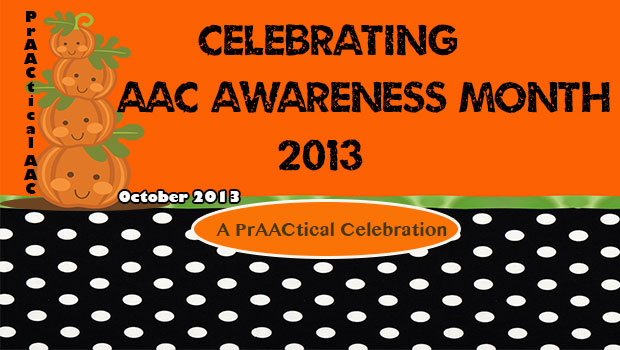
Celebrating AAC Awareness Month is fun and exciting. We are hearing great stories about how AAC is impacting students, children, adults, families, educators, & SLP’s. Our PrAACtical AAC celebration could not happen without the generosity of so many companies and developers. We have been overwhelmed by their continued support. We could not be more THANKFUL. Their apps, software, and products help AAC users learn communication and language with optimal success. Be sure to enter for a chance to win awesome prizes that will help you teach AAC to ALL people who need it. From AAC, assessment , continued professional development, literacy, to communication everywhere there are amazing options. GOOD LUCK! Ablenet, Inc Abilipad Alexicom BeeVisual/ChoiceWorks Close 2 Home Apps Dynavox/Mayer Johnson Handhold Adaptive Hump Software MarbleSoft Mozzaz News-2-You Paul H. Brookes Publishing Company Safe N Sound Mobile Silver Lining Multimedia Smarty Ears Speak For Yourself SpeechPathology.com SpeechTree TapSpeak TherapyBox/TBoxApps TouchChat... [Read More...]
October 12, 2013
by Robin Parker -
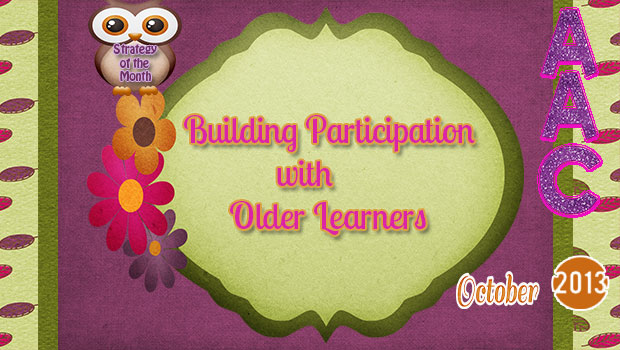
We love active participation for communication and language learning. Actually, we love active participation in all areas of life for us, for our students, for everyone. When Carole introduced the Building Participation Strategy of the Month, she discussed the role of the Participation Model (Beukelman & Mirenda, 1988; 2013). The Participation Model is a framework for understanding the barriers to participation and then from a prAACtical intervention standpoint developing strategies and activities to increase active participation in a variety of (ALL) aspects of life. For the 2012 AAC Awareness Month, we discussed barriers to participation. This year’s focus is on activities and strategies for getting past the barriers to building age appropriate authentic active participation for ALL learners. We have learned that when older learners with significant communication challenges are provided with age appropriate activities and supports, they can be engaged and motivated to participate and can often surprise us with... [Read More...]
October 5, 2013
by Carole Zangari -
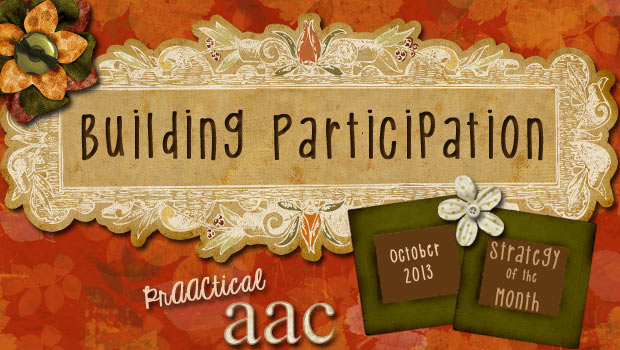
Do you know any of our friends? Jenna can use a talking switch with only a little bit of support. But at calendar time, no one thinks of asking her a question. Hao knows almost two dozen signs and can use a communication wallet with non-signers. But at social gatherings, he’s mostly off to the side playing a game on his iPhone. Isaac uses his SGD capably and can create grammatically correct sentences that include noun phrases and conjunctions. But in Chemistry, his lab group conducts their experiments and writes up the lab report without his contributions. Sienna is able to choose between preferred and non-preferred items in a field of three and is learning to do so in a field of four. But the only time she gets to make a choice is at mealtimes. Like many of you, we put in countless hours helping children and adults who... [Read More...]
September 26, 2013
by Robin Parker -
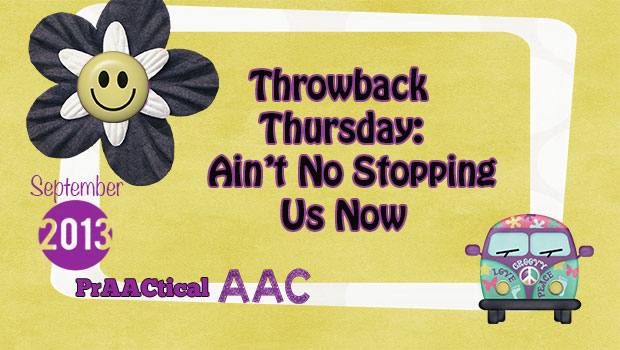
(updated/original version published on October 20, 2012) Sometimes saying ‘no’ to the demands of the day actually helps us rejuvenate and allows us to be more productive. Saying ‘no to false information helps us to advocate for ourselves. The ‘no’ topic seems to be trending now. There have been quite a few blog posts and comments about the issue (Just Say No, How and When to Give Your Students A Break). We are so glad that this topic is getting more focus. Of course everyone agrees that ALL people have the right to say ‘no’. But it is not always so simple. There are many types of ‘no’. There is the outright ‘no’, the ‘no’ to more work, the ‘no’ for disagreement, the ultra important ‘NO’ to unwanted touching, and many more. And depending upon how you say ‘no’ is the difference between it being accepted or… NOT. The issue... [Read More...]
September 24, 2013
by Robin Parker -
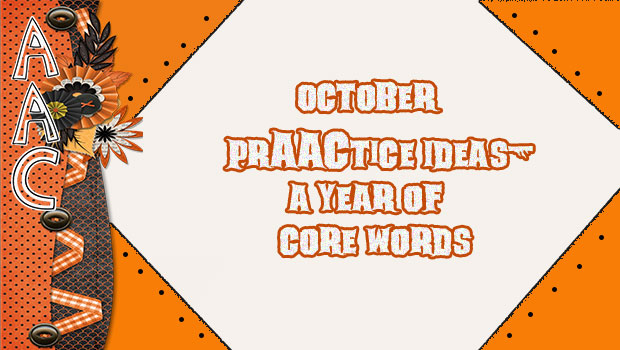
More core word prAACtice ideas. To make core word prAACtice most successful, make sure everyone has access to a core word AAC display and you have some clearly defined communication goals. Then select activities that encourage social interaction, have a shared focus, and are mostly about the process of learning. Build in lots of communication opportunities to use specific target words for both you and the learner. For October, meaningful communication and language activities can include art projects, costume parties with photo’s, gardening/planting, and music/concerts. October has so many great options for fun socially motivating activities that all you have to do is go have fun and model on. OCTOBER WORDS another “another turn” “have another one” “we need another surprise” “We hope he does another song for us” change “change clothes” “please give me change” “I need to change it for the other one” “She will change her mind... [Read More...]
September 21, 2013
by Carole Zangari -
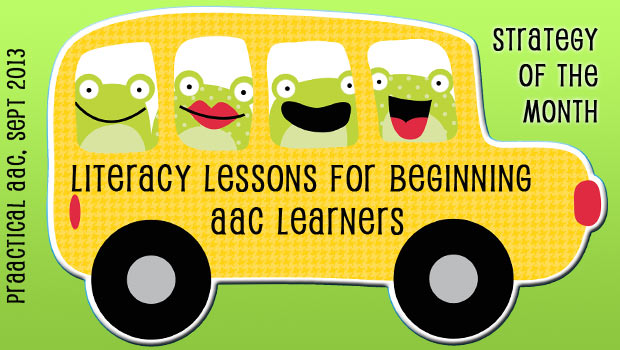
Like some of you, we are often met with skepticism when we encourage teams to work on literacy skills with individuals who are still learning the very basics of communication. Recently, we had the opportunity to begin this journey anew, and model a literacy lesson for kindergartners who have no formal communication system, are not answering yes/no questions, and do not consistently select preferred items when offered choices. Why work on literacy with students who are not routinely expressing their basic preferences? Because the longer we wait, the longer it will take to get there. Because it offers wonderful opportunities to build communication, too. Because when other people see us teaching reading and writing, it changes their perception of the student in a positive way. Because they will enjoy it. Because there are mandates for us to address the general education curriculum. Because if we set the bar high and... [Read More...]
September 17, 2013
by Robin Parker -
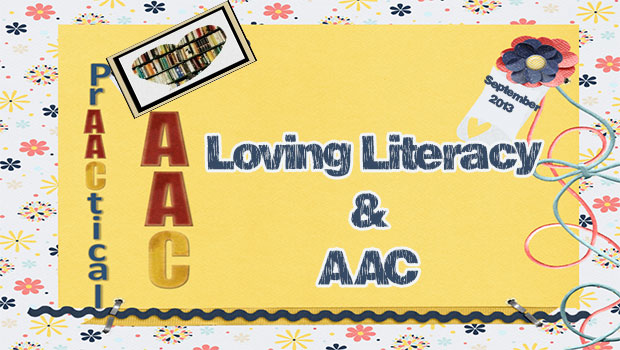
It’s International Literacy Month. We want to take this opportunity to remember that EVERYONE should have direct literacy instruction. Some students will be starting by learning to enjoy books while others will be readers already. Either way, there should be a literacy plan with short term and long term goals. If you need ideas for beginning or just expanding reading skills, here are some seriously excellent literacy resources for AAC. Take a look, enjoy and please let us know your favorite literacy resources so we can add them to this list. TalkSense- 101 ideas for literacy and AAC. Also, provides access to many picture symbols and litSymbols Jane Farrall’s Blog: Literacy, AAC, & Assistive Technology– Literacy resources specific to AAC and assistive technology Tar Heel Reader – books for beginning readers of all ages. Bookshare- accessible books and journals for readers with print disabilities Center for Literacy and Disabilities Studies–... [Read More...]
September 14, 2013
by Robin Parker -
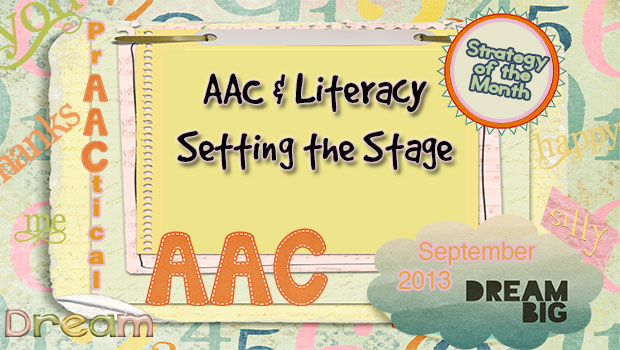
Literacy is for all students. As with most things we learn, emergent readers and writers need to be active participants with print across multiple settings and in multiple meaningful experiences. Emergent readers need to be taught to integrate reading and writing with communication and language. To facilitate this comprehensive integration and understanding, SLP’s and educators can use a variety of authentic research based strategies to help. Create a literacy enriched environment- Literacy skills are promoted through an environment with lots of reading and writing materials. Text based labels and signs will help bring meaning to text in authentic experiences. As you plan activities, include options for writing time/centers, and reading time/centers. Have books accessible to learners. Have lots of book options, but also help students independently turn pages (make it easy with page fluffers), reach books, use writing materials, etc. During interactive activities, give learners a choice of 2 or more books to... [Read More...]









